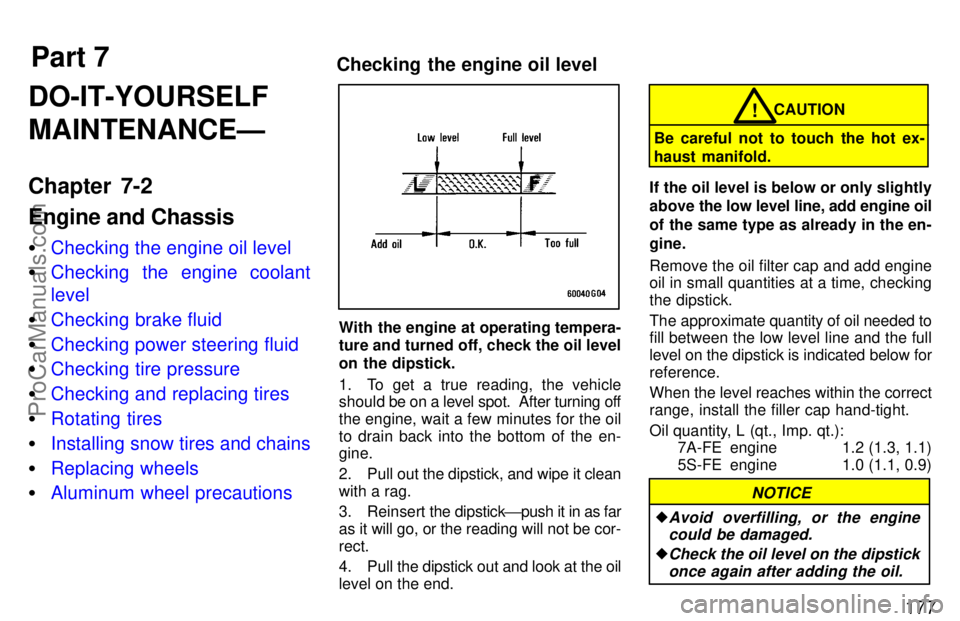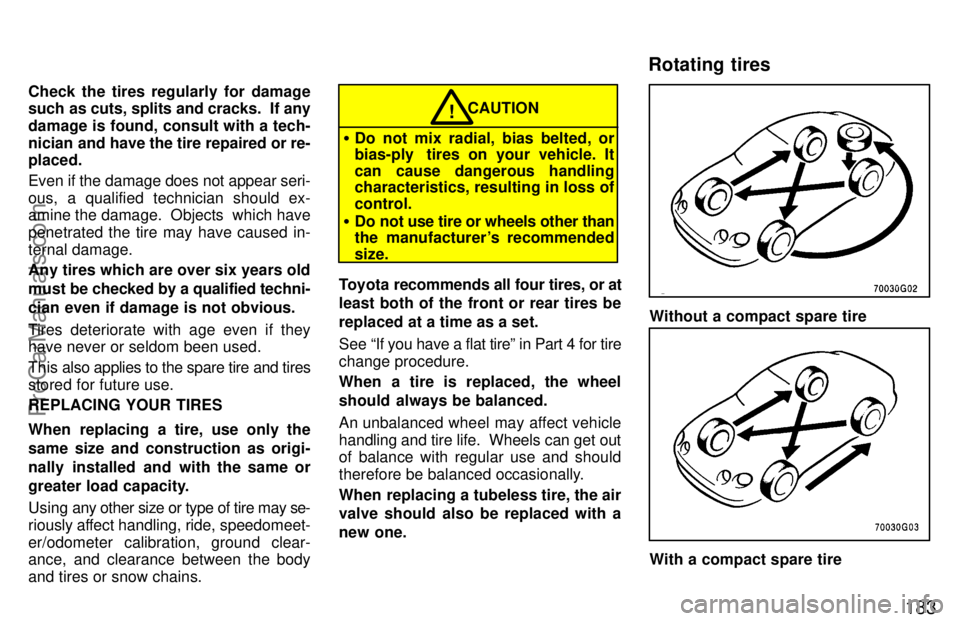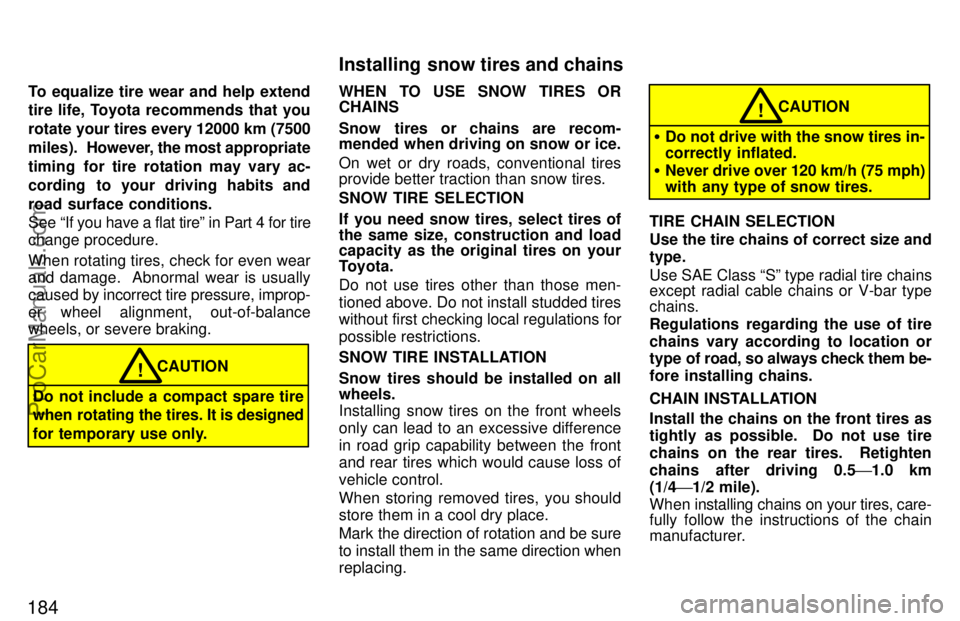Page 183 of 218

Part 7Checking the engine oil level177
DO-IT-YOURSELF
MAINTENANCEÐ
Chapter 7-2
Engine and Chassis
�Checking the engine oil level
� Checking the engine coolant
level
� Checking brake fluid
� Checking power steering fluid
� Checking tire pressure
� Checking and replacing tires
� Rotating tires
� Installing snow tires and chains
� Replacing wheels
� Aluminum wheel precautions
With the engine at operating tempera-
ture and turned off, check the oil level
on the dipstick.
1. To get a true reading, the vehicle
should be on a level spot. After turning off
the engine, wait a few minutes for the oil
to drain back into the bottom of the en-
gine.
2. Pull out the dipstick, and wipe it clean
with a rag.
3. Reinsert the dipstick'push it in as far
as it will go, or the reading will not be cor-
rect.
4. Pull the dipstick out and look at the oil
level on the end.
CAUTION
Be careful not to touch the hot ex-
haust manifold.!
If the oil level is below or only slightly
above the low level line, add engine oil
of the same type as already in the en-
gine.
Remove the oil filter cap and add engine
oil in small quantities at a time, checking
the dipstick.
The approximate quantity of oil needed to
fill between the low level line and the full
level on the dipstick is indicated below for
reference.
When the level reaches within the correct
range, install the filler cap hand-tight.
Oil quantity, L (qt., Imp. qt.): 7A-FE engine 1.2 (1.3, 1.1)
5S-FE engine 1.0 (1.1, 0.9)
�
Avoid overfilling, or the engine could be damaged.
�Check the oil level on the dipstick
once again after adding the oil.
NOTICE
ProCarManuals.com
Page 189 of 218

183
Check the tires regularly for damage
such as cuts, splits and cracks. If any
damage is found, consult with a tech-
nician and have the tire repaired or re-
placed.
Even if the damage does not appear seri-
ous, a qualified technician should ex-
amine the damage. Objects which have
penetrated the tire may have caused in-
ternal damage.
Any tires which are over six years old
must be checked by a qualified techni-
cian even if damage is not obvious.
Tires deteriorate with age even if they
have never or seldom been used.
This also applies to the spare tire and tires
stored for future use.
REPLACING YOUR TIRES
When replacing a tire, use only the
same size and construction as origi-
nally installed and with the same or
greater load capacity.
Using any other size or type of tire may se-
riously affect handling, ride, speedomeet-
er/odometer calibration, ground clear-
ance, and clearance between the body
and tires or snow chains.
CAUTION
� Do not mix radial, bias belted, or
bias-ply tires on your vehicle. It
can cause dangerous handling
characteristics, resulting in loss of
control.
� Do not use tire or wheels other than
the manufacturer's recommended
size.!
Toyota recommends all four tires, or at
least both of the front or rear tires be
replaced at a time as a set.
See If you have a flat tireº in Part 4 for tire
change procedure.
When a tire is replaced, the wheel
should always be balanced.
An unbalanced wheel may affect vehicle
handling and tire life. Wheels can get out
of balance with regular use and should
therefore be balanced occasionally.
When replacing a tubeless tire, the air
valve should also be replaced with a
new one.
Without a compact spare tire
With a compact spare tire
Rotating tires
ProCarManuals.com
Page 190 of 218

184
To equalize tire wear and help extend
tire life, Toyota recommends that you
rotate your tires every 12000 km (7500
miles). However, the most appropriate
timing for tire rotation may vary ac-
cording to your driving habits and
road surface conditions.
See If you have a flat tireº in Part 4 for tire
change procedure.
When rotating tires, check for even wear
and damage. Abnormal wear is usually
caused by incorrect tire pressure, improp-
er wheel alignment, out-of-balance
wheels, or severe braking.
CAUTION
Do not include a compact spare tire
when rotating the tires. It is designed
for temporary use only.!
WHEN TO USE SNOW TIRES OR
CHAINS
Snow tires or chains are recom-
mended when driving on snow or ice.
On wet or dry roads, conventional tires
provide better traction than snow tires.
SNOW TIRE SELECTION
If you need snow tires, select tires of
the same size, construction and load
capacity as the original tires on your
Toyota.
Do not use tires other than those men-
tioned above. Do not install studded tires
without first checking local regulations for
possible restrictions.
SNOW TIRE INSTALLATION
Snow tires should be installed on all
wheels.
Installing snow tires on the front wheels
only can lead to an excessive difference
in road grip capability between the front
and rear tires which would cause loss of
vehicle control.
When storing removed tires, you should
store them in a cool dry place.
Mark the direction of rotation and be sure
to install them in the same direction when
replacing.CAUTION
� Do not drive with the snow tires in-
correctly inflated.
� Never drive over 120 km/h (75 mph)
with any type of snow tires.!
TIRE CHAIN SELECTION
Use the tire chains of correct size and
type.
Use SAE Class Sº type radial tire chains
except radial cable chains or V-bar type
chains.
Regulations regarding the use of tire
chains vary according to location or
type of r oad, so always check them be-
fore installing chains.
CHAIN INSTALLATION
Install the chains on the front tires as
tightly as possible. Do not use tire
chains on the rear tires. Retighten
chains after driving 0.5 '1.0 km
(1/4 '1/2 mile).
When installing chains on your tires, care-
fully follow the instructions of the chain
manufacturer.
Installing snow tires and chains
ProCarManuals.com
Page 191 of 218

185
If wheel covers are used, they will be
scratched by the chain band, so remove
the covers before putting on the chains.
�Do not exceed 50 km/h (30 mph) or
the chain manufacturer's recom-
mended speed limit, whichever is
lower.
� Drive carefully avoiding bumps,
holes, and sharp turns, which may
cause the vehicle to bounce.
� Avoid sharp turns or locked-wheel
braking, as use of chains may ad-
versely affect vehicle handling.
CAUTION!
Do not attempt to use a tire chain on
the compact spare tire, as it may
result in damage to the vehicle aswell as the tire.
NOTICE
WHEN TO REPLACE YOUR WHEELS
If you have wheel damage such as
bending, cracks or heavy corrosion,
the wheel should be replaced.
If you fail to replace damaged wheels, the
tire may slip off the wheel or they may
cause loss of handling control.
WHEEL SELECTION
When replacing wheels, care should
be taken to ensure that the wheels are
replaced by ones with the same load
capacity, diameter, rim width, and off-
set.
This m ust be observed on compact spare
tires, too.
Correct replacement wheels are available
at your Toyota dealer.
A wheel of a different size or type may ad-
versely affect handling, wheel and bear-
ing life, brake cooling, speedometer/
odometer calibration, stopping ability,
headlight aim, bumper height, vehicle
ground clearance, and tire or snow chain
clearance to the body and chassis. Replacement
with used wheels is not rec-
ommended as they may have been sub-
jected to rough treatment or high mileage
and could fail without warning. Also, bent
wheels which have been straightened
may have structural damage and there-
fore should not be used. Never use an in-
ner tube in a leaking wheel which is de-
signed for a tubeless tire.
Replacing wheels
ProCarManuals.com